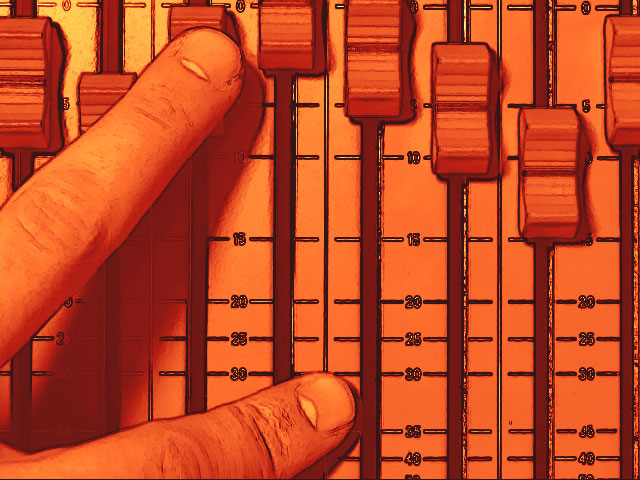- Published Jun 18, 2013 in In The Studio
A great mix isn’t just about getting technical. It has just as much to do with using your ears and intuition to coax a great sound out of the speakers.
Feeling the mix. Oh, it could mean feeling its pain, or kind of a shady raincoat vibe. But what I’m talking about is when you know a mix is right, powerful.
Monitoring volume always goes up when mixing. Fight the impulse to turn it up as you go along by starting with a moderate level—you could have a conversation with someone in the room without yelling. Take note of where the dial is set and then treat the volume knob like it has a taze setting if you turn it up.
Go as long as you can building your mix at a consistent, moderate volume. You will eventually need to turn it up and also turn it way down. But during the majority of the process, try to stay moderate in monitoring volume. Do this for a couple of reasons: first, it’s no amazing feat to have tunes sound good when they are cranked. Almost everything sounds powerful when it’s loud and blowing your hair back like you’re out for a spin with the top down.
Second, live to mix another day. Stay loud long enough and one day—maybe not for awhile, but one day—you won’t have the ears to really EQ or mix in a way that’s any use in the real world. I know the last one sounds like me being your mom as you sit inches from the TV screen but think of it more like: pros mix at moderate levels, beginners crank it up. Which do you wanna be?
When to turn up.
I do—and must—turn the volume up, especially when I put the mix on bigger speakers (Assuming you have the luxury of switching between near-field speakers, usually 6 or 8 inch speakers placed near you, and larger speakers, 12 inch woofers on up to jumbo size).
Warning: once a clients hears his tune on big, loud speakers, they generally only want to hear it that way from then on. You can do that for them at the end of the session so they feel enormous before they head out the door, but you are doing them no service when it comes to precision which is what’s needed.
So I do turn it up on bigger speakers at various stages. I check bass and kick phase and EQ mostly on the big speakers, and then again for placements (vocals or guitars), and then at the end to see how the mix feels. I also use the near-field monitors and turn them way down, almost to a whisper. This helps judging vocal placement (harmony and lead vocals). And if I can still hear a little bass at low volume on small speakers, it’s getting about right.
Take a break.
I also take frequent “ear breaks” when I just turn everything off for 5 or 10 minutes and let my ears cool down. It’s amazing what perspective this will give you when you hit play again and hear where you last left off. Many times I find that that thing I was microscopically focused on was not bold enough and I’d missed the big picture, or that I was making something blisteringly loud in the mix because I was over focused.
Time to listen.
Okay, so you’ve stayed moderate in your volume with the exception of a few twists up and down to check things, and you’ve taken a bunch of ear breaks to keep you moving forward. You’ve done a good mix, now you take a listen.
Nice but it’s missing something. Something almost indefinable, something that transcends genre. You’re missing a girth; a power; a coming at you, popping out of the speakers-ness.
The answer is: be bold. Get out of the oh-so-subtle and into the up-front-in-yo-face! Be bolder on your drum compression, a bit more aggressive on the master buss, increase the guitars by a half db. Lean in, childrens, lean in.
The first impression.
You have one chance with a listener, the first time they hear it. They will not be overwhelmed with the subtlety of you mix. You must grab them. When you start heading down this path you’ll notice you don’t need to turn it up, the speakers start to ring in the right way, the mix gets broader.
No, I’m not talking about Metallica mastering levels or putting a maximize on everything. I’m taking about feeling the mix, the power of the song, that moment you cross over from just getting it right to getting an audience to feel it. Even you yourself start tapping your foot, bobbin’ your head, you are now starting to feel the mix. You don’t feel the need for volume because it sounds loud and moving and phat as is.
Don’t be afraid to go over. It’ll let you know when you’ve broken it. Take a step back and it will reemerge. All the subtle textures will still be there—all your nuanced verbs will still be there. But now a person who hasn’t heard the song 874 times will also hear those things and, in later listens, marvel at your intricate attention to detail. But they never would have noticed if you didn’t “feel the mix”.
So, be bold while all the while keeping it cool on the volume.

